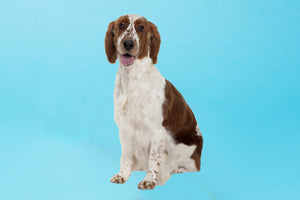
FREE UK DELIVERY ON ORDERS OVER £39.99

Breed History
The Irish Wolfhound, unsurprisingly, hails from the Emerald Isle and was initially bred as a sighthound to hunt large game such as deer and wolves.
General Appearance
Irish Wolfhounds are impressively large dogs, reaching heights of 88cm; taller than some Shetland ponies! The coat of the wolfhound can be a range of colours including grey, black, red and fawn. However, most individuals are the same grey/black as a wolf. They have a bushy beard and eyebrows, lending them an interesting expression.
Temperament
Some use the phrase ‘gentle when stroked, fierce when provoked’ to describe the temperament of the Irish Wolfhound. In general, they are a placid and tolerant dog. However, they can be protective of their home and owners and will make good guard dogs if desired.
Health Considerations
The Irish Wolfhound has a relatively short life span of between 6 to 10 years. While the height of the Wolfhound is striking, it can lead to health problems. Wolfhounds are prone to diseases such as Dilated Cardiomyopathy, Bloat and Hip Dysplasia. Feeding them Health & Digestion to tackle the bloat or Joint Care will strengthen bones in regards to preventing Hip Dysplasia. Purchasing your pup from a reputable breeder who screens their breeding stock can help ensure your pup grows into a healthy adult.
Trainability
Irish Wolfhounds are relatively easy to train and work well with positive reinforcement. It’s good to note that in their first year or life they can be a little slow to mature so starting with obedience training is a must.
Grooming
Their wiry coat should be brushed through a few times a week (a task which is a workout in itself!).
Exercise
Your Irish Wolfhound will require a minimum of 2 hours walking/hiking per day and is not generally well suited to off-lead exercise. Having a good outdoor space is essential when raising an Irish Wolfhound and is particularly handy when long walks are not possible (for example, during heatwaves).
Feeding Considerations
Due to their size, the cost of feeding your Wolfhound will be significantly greater than smaller breeds. As they are a large breed with a deep chest it’s important to be mindful of bloat. Always aim to feed your dog from the floor and do not exercise them right before, or right after a meal.
You'll find a handy feeding calculator on every product page here at Pooch & Mutt to help you identify how much of our health led recipes are right for the age, size and weight of your dog.
Comments (0)
Leave a comment